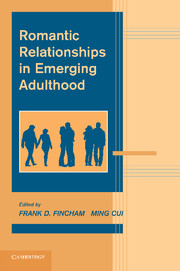Book contents
- Frontmatter
- Contents
- List of Contributors
- Foreword
- PART I INTRODUCTION
- PART II CONCEPTUAL AND METHODOLOGICAL FOUNDATIONS
- 2 Romantic Relationships in Emerging Adulthood: Conceptual Foundations
- 3 Relationship Sequences and Trajectories: Women's Family Formation Pathways in Emerging Adulthood
- 4 Models of Change and Continuity in Romantic Experiences
- 5 Working With Dyadic Data in Studies of Emerging Adulthood: Specific Recommendations, General Advice, and Practical Tips
- PART III THE DEVELOPMENTAL CONTEXT OF ROMANTIC RELATIONSHIPS IN EMERGING ADULTHOOD
- PART IV RELATIONSHIP PROCESSES IN EMERGING ADULTHOOD
- PART V PRACTICAL IMPLICATIONS
- Index
- References
5 - Working With Dyadic Data in Studies of Emerging Adulthood: Specific Recommendations, General Advice, and Practical Tips
Published online by Cambridge University Press: 06 December 2010
- Frontmatter
- Contents
- List of Contributors
- Foreword
- PART I INTRODUCTION
- PART II CONCEPTUAL AND METHODOLOGICAL FOUNDATIONS
- 2 Romantic Relationships in Emerging Adulthood: Conceptual Foundations
- 3 Relationship Sequences and Trajectories: Women's Family Formation Pathways in Emerging Adulthood
- 4 Models of Change and Continuity in Romantic Experiences
- 5 Working With Dyadic Data in Studies of Emerging Adulthood: Specific Recommendations, General Advice, and Practical Tips
- PART III THE DEVELOPMENTAL CONTEXT OF ROMANTIC RELATIONSHIPS IN EMERGING ADULTHOOD
- PART IV RELATIONSHIP PROCESSES IN EMERGING ADULTHOOD
- PART V PRACTICAL IMPLICATIONS
- Index
- References
Summary
There is increasing recognition that human development is embedded in interpersonal contexts throughout the lifespan (e.g., Reis, Collins, & Berscheid, 2000), and this is especially true of development during emerging adulthood. Indeed, a salient developmental task of this period is to negotiate the challenges of establishing intimate relationships with romantic partners (Arnett, 2000, 2004). Researchers who pursue studies of relationships during this period of the lifespan therefore need both conceptual and methodological sophistication with respect to dyadic data analysis. Despite the fact that interdependent data present special analytic challenges (e.g., Kashy & Snyder, 1995; Kenny, 1998; Kenny, Kashy, & Cook, 2006), the application of appropriate statistical techniques for dyadic data offers important opportunities to better understand the nature and functioning of relationships. As such, the broad objective of this chapter is to introduce researchers to the methodological and analytic issues that are most relevant when considering dyadic data from romantic couples.
Our chapter builds on a recent monograph published by Kenny et al. (2006), and we readily acknowledge that a relatively short chapter cannot serve as a substitute for a book-length treatment of the relevant issues. Even so, this chapter expands on some of the most fundamental topics in that book and provides a gentle introduction to the major issues that are prominent when studying romantic dyads.
Information
- Type
- Chapter
- Information
- Romantic Relationships in Emerging Adulthood , pp. 67 - 98Publisher: Cambridge University PressPrint publication year: 2010
References
Accessibility standard: Unknown
Why this information is here
This section outlines the accessibility features of this content - including support for screen readers, full keyboard navigation and high-contrast display options. This may not be relevant for you.Accessibility Information
- 8
- Cited by
